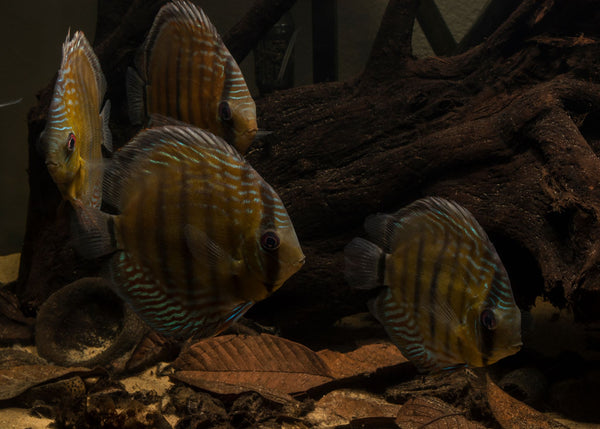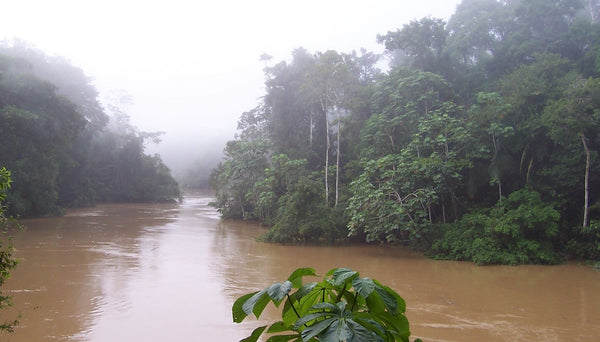- Continue Shopping
- Your Cart is Empty
Slipping through the seasons...
As you likely have figured out by now, we have a certain obsession here with replicating the form and function of Nature, to the greatest extent possible. And of course, the "function" part is often more of a challenge than the "form", so any processes found in Nature that we can replicate to some extent not previously executed in an aquarium is an evolution of sorts in our process, and a true "win" for the hobby.

Perhaps one of the more obvious, yet less tackled aspects of Nature that we can work on is...change.
Yeah.
If there is one constant in nature, it's change.
And it's kind of ironic to me that one of the things we typically strive to avoid in fish keeping is change...well, rapid environmental change, anyways. Yet, we are typically sort of modeling our aquariums after a natural habitats, many of which do undergo significant periodic or seasonal changes during the course of a year, don't they? Yet, although we are replicating some cool natural habitats as never before, we don't usually vary environmental conditions throughout the year in our aquariums...
In fact, they're almost sort of "static" in terms of intentional seasonal changes, right?
Why is this?

I suppose it's another case of, "We do it this way because it's how we've done it for a century..."
Perhaps its time to loosen the chains of "conventional aquarium practice" and look towards some largely unexplored waters, right? Could there be something to be gained by modeling our aquariums after natural habitats during different times of the year? Some benefits for our fishes and the other organisms we want to nurture in our closed aquatic systems?
I think so!
Seasonal change is hugely impactful in tropical regions.
Its influence at every level is significant. Even the larger lakes undergo seasonal changes. For example, Lake Tanganyika, the second deepest lake in the world, undergoes surface water temperature changes throughout the year in its upper layers. Surely these have impact on the distribution, spawning, and feeding habits of the resident fishes, right?

In Amazonia, floodplain lakes associated with the river also undergo seasonal changes, which affect water quality. At high water phase, the large amount of nutrient input from the terrestrial environment causes the increase of primary productivity, and can lead to the lakes becoming very "eutrophic."
This also has an impact on the fishes which live there.

And of course, we all know about the annual killifishes of Africa and South America, which have adapted over eons to the varying seasonal conditions of rainfall and desiccation. They inhabit slowly evaporating pools, puddles, and wetlands, that dry out and fill once again during the rainy season-whenever that may be- and are highly variable, yet very dynamic environments, which give both life and death to the killies and other aquatic life forms which reside in them.

As hobbyists, I'd hazard a guess that we (unconsciously) tend to model our aquariums after one season in the wild habitats (if we even consider seasons at all), not really taking into account the significant changes that occur in these environments at various times of the year. If you look at it from a "literal" perspective, not taking into account the hobbyists who work with annual killies, for most of us, it's sort of "always the wet season" in our aquariums, right?

Now, there is certainly nothing wrong with this approach.
After all, we're into keeping fishes, not creating recreations of of dry rainforest floors or empty mud holes! Well, maybe not just yet...And we should!
I just think that it would be kind of cool to model our aquariums after typical environments as they look and function at different times of the year. We've already touched on the flooded Igapo forests of Brazil, in which the forest floor becomes seasonally inundated by overflowing streams and rivers. It's an amazingly dynamic habitat that I'm glad we're starting to see more interest in.
Yet, I wondered for years how interesting it would be to take it even further, and create an aquarium around the seasonal changes in such a habitat. You know, with more shallow water levels, a greater ratio of botanicals/substrate to water, and different temperatures, lighting, etc.?
That was the basis of my "urban igapo" idea- starting out with a dry, "terrestrial" habitat and gradually flooding it to simulate the seasonal inundations which these habitats go through annually. I've done this several times, nuancing various aspects like soil composition, planting, and fish stocking along the way. It's become one of my fave projects, and I hope to see many of you playing with the idea more!

To that end, I've worked on varying soil "recipes" for both the igapo and varzea habitats, which operate similarly, yet have distinctly different physical characteristics. These become quite obvious when you begin playing with more functional environmental replications of them, too!

And of course, it's not just about these Amazonian habitats...there are numerous other habitats around the world that are suitable for such simulations.
What about a vernal pool in Africa that houses annual killifish?
Could lowering the water level significantly at various times of the year perhaps trigger specific behaviors related to the onset of the dry season? We already have a good handle on the spawning of annual fishes like Nothobranchius, and how CO2 and such affects egg viability, development, and hatching times ( a concept known as "diapause"), but I wonder if we could gain even more insight into the fishes themselves by gradually decreasing water levels to simulate this seasonal change?
Or perhaps even changing food sources to simulate the varying resources which are available during different seasons?

There are many fishes which could benefit from such replications.
If you recall, not too long ago, we talked about the Zebra Danio, and how it adapts to changing conditions in its native habitats. Typically, these fishes are found in Northern India, and this area is subjected to seasonal rainfall between the months of June and September due to the summer Monsoon, and the water levels and characteristics vary considerably at different times of the year.
They are often found in inundated rice paddies and marginal pools, with silty, kind of turbid water with very little movement. During the dry times of the year, they spend their time in calm, shaded areas of streams, with rocky substrates. How interesting it would be to give them "monsoonal" conditions, versus the conditions more typical of the dry season that we tend to provide them in aquariums!

I find examining these seasonal changes in the natural habitats and how they affect our fishes irresistible! There is something very alluring about perhaps gaining some small insights into how the environmental changes that occur throughout the year affect our fishes. I mean, there's more to it than simply raising and lowering water levels or temperature, but those a re good places to start, right?
What kinds of secrets could you unlock about your fishes by manipulating factors such as turbidity, water movement, substrate/botanical additions or subtractions, varying light intensity/duration, temperature (we've done this to some extent), pH, and even food supply? There is a lot of great scholarly data out there on almost any tropical environment you can think of, and with the concern over climate change, there is a lot of scientific information analyzing seasonal variations in all sorts of aquatic habitats worldwide.
It's out there for the bold, motivated hobbyist to apply to our aquarium work.

The passing of seasons, and varying environmental conditions they create are fascinating opportunities for us as hobbyists to examine and learn about how our fishes interact with their environments, and how we might be able to create even more successful outcomes for a wider variety of fishes. Perhaps we could get some "movement" with some which have typically eluded or proven difficult to spawn to date using more "traditional" approaches.

I've been working with brackish habitats for a while now, and, although I've played around quite a bit with the water and substrate composition, I have yet to fully examine the idea of tidal influences- more frequent changes to the habitats...something that has not been worked with very much in home aquariums in the past. I think that there might be much to gain from replicating such fluctuations in the aquarium.

Mangroves are fascinating trees, and have proven to be adaptable, resilient, and quite easy to grow in captive systems. The impact of tidal changes, lighting, and substrate composition are all dynamics that we can and should study more in the context of our aquairums. These amazing trees are know to foster and support a very rich, dynamic ecosystem of both flora and fauna in Nature, which creates a significant food chain.
We can certainly make a greater effort to recreate this food chain-and its benefit- in our aquariums!

What secrets could we unlock by playing with some of these ideas? There is so much more than just a cool look, believe me! Their extensive prop root systems and adaptations to the substrates they grow in alone could provide many years of breakthrough aquarium work- and fun- for those who choose to study it a bit more!

Amazing stuff that we can unlock simply by looking at things just a bit differently...
Now, sure, we already play around with some environmental conditions in order to induce spawning in our fishes, which is well-documented, so why not play around with (or at least, examine) various types of seasonal conditions for fishes to see what other impacts we can influence (i.e.; greater growth rate, coloration, appetite, etc.)?

With all of the amazing curiosity, talent, and creativity in our growing global community of adventurous aquarists, there is a ton of room for amazing work and even some breakthroughs!
I hope that I've piqued the interest of at least a few of you into taking a different sort of look at the way we plan, develop, and manage our aquariums. Not that taking such an approach will guarantee groundbreaking results, sure to change the way we keep our fishes (it might!)- but it might just stimulate more ideas, more discussions, and facilitate the "connecting-of-the-dots" process of weaving together what we already know with what we haven't yet tried.

Simply influencing other hobbyists to look beyond just the aesthetics, and to consider how the natural ecosystems that we tend to replicate these aspects of actually function- and that these functions can be replicated with greater detail if we apply the same zeal to this stuff that we do to the "look!"
And, understanding these natural processes and replicating more and more of them in our aquariums can expose more and more people- even non hobbyists- to the wonder and fragility of these fascinating aquatic ecosystems, fostering a greater demand to protect them.
It's an amazing time to be an aquarist, isn't it?
I mean, we have the fishes, the technology, the materials, and the means to research arcane topics once considered solely the domain of scholars. We can actually execute on many of these things. We can try playing with concepts that we've likely never given much thought to previously. And we can rapidly communicate and share our ideas, successes, challenges, failures, and overall progress with fellow hobbyists all over the planet.
Nature is calling.

This is how quantum shifts occur in the hobby. It's how significant evolutions in understanding and executing take place.
Yeah, those "passing fancies" might just create some entirely new paradigms for our hobby. Let's hope!
We just need to jump in and get our hands wet!
Stay studious. Stay excited. Stay resourceful. Stay creative. Stay adventurous.
And Stay Wet.
Scott Fellman
Tannin Aquatics








Scott Fellman
Author